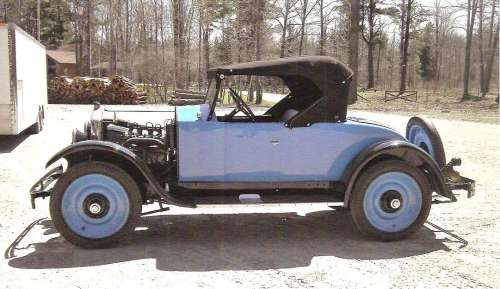Inspection
There are four parts to a thorough vehicle inspection of an antique, vintage or classic car or truck. One is to inspect the inside from top to bottom for wear and tear and to verify that all the controls and buttons work as they should. The second is inspect the outside in a similar manner, looking for rust, dents and scratches and testing everything that moves such as door handles and locks. You should also check all the lights because what appears to be a burnt out light bulb could be a more serious problem. The third step is to take a test drive and again verify that everything works as it should. Take the vehicle on a freeway to verify that it does not shake or drift and drive on a bumpy road to listen for rattles.

1924 Hupmobile Model R
And if the seller insists on going take along a friend to engage him or her so that you can concentrate on the vehicle. You should also ask to look at maintenance records and receipts for significant repairs or restoration so you can compare the documented odometer reading and replaced parts with what you see. And finally, if you are still serious about buying the vehicle, arrange to have the engine and drivetrain inspected by a qualified mechanic "of your choosing". Given the anxiety and confusion that generally accompany a purchase it is easy to overlook important and potentially costly items so use a check list (like the one below) and take lots of pictures inside and out for future reference. The list at the bottom of this page will help.
Test Drive
There are many problems that may occur related to road handling. Considering the many factors that can influence road handling, it is difficult to understand sometimes why a vehicle perform in a certain manner on the road. Road handling can be affected by the characteristics of the car, the weather conditions, as well as the road conditions, by the familiarity of the driver with the car, as well as the position and support for the driver while driving.
Over steer.Over steer occurs when the back wheels have a tendency to slip towards the outside of the turn rather than the front. In this position, the car is exposed to spinning and the driver would not be able to correct the car's position by steering from the corner. Over steer is not always bad and many drivers use it as an advantage by applying power at a given point.
Under steer: Under steer is the opposite of over steer and it happens when the front wheels of motors tend to crawl towards the outside of the turn. In such conditions, the car is difficult to handle even though under steer can be controlled through tighter turning. Unlike over steer, under steer makes the car behave in a less predictable manner and also causes tires to be worn out much quicker.
Body roll: Although it is often confused with over steer or under steer, body roll is in fact the situation when the car tends to lean towards the outside of the curve. In such a case, the driver should not change direction unless the car has completed the leaning process. A specific delay in steering change can be noticed in cars that experience body roll. The weight born by the tires is also affected.
When you are buying a car second hand car you should safety check the vehicles and have a specialist look at the car, there are many trustworthy sites such as but it's vital to double check through professionals. There are other problems that motors can experience as far as road handling including bump steer, excessive load transfer, and slow response.
Vehicle Inspection & Test Drive Checklist
| Vehicle Inspection & Test Drive Checklist | |||||||
| Year: | Make: | Model/Style: | |||||
| VIN#: | Miles: | ||||||
| Visual Condition Outside | Good | OK | Bad | Visual Condition Inside | Good | OK | Bad |
| Body & Paint | Carpet & Floor Mats | ||||||
| Chrome, Mirrors & Insignias | Seats & Upholstery | ||||||
| Glass | Lights & Instruments | ||||||
| Fabrics | Dash & Mirror | ||||||
| Wheels & Tires | Door Panels & Headliner | ||||||
| Hinges & Handles & Locks | Glove box & Ash Trays | ||||||
| Lights | Radio & Accessories | ||||||
| Test Drive | Steering Wheel & Turn Signals | ||||||
| Idle | Gas & Brake Pedals | ||||||
| Acceleration | Hand Brake | ||||||
| Power | Door Handles & Locks | ||||||
| Down-Shifting | Trunk | ||||||
| Up-Shifting | Carpet | ||||||
| Clutch | Light | ||||||
| Steering | Spare Tire | ||||||
| Brakes | Hinges & Locks | ||||||
| Suspension | Under Hood | ||||||
| Road Noise | Battery | ||||||
| Heat & Air Conditioning | Brake Fluid | ||||||
| Underneath | Power Steering Fluid | ||||||
| Exhaust System | Radiator Coolant | ||||||
| Drive Line | Automatic Transmission Fluid | ||||||
| Differential Oil | Belts & Hoses | ||||||
| Manual Transmission Oil | Air Filter | ||||||
| Hoses & Cables | Oil leaks | ||||||
| Leaks | Hinges & Latch | ||||||
Here is some more information about antique, vintage and classic vehicles. You will find services and resources in our Business Directory.



